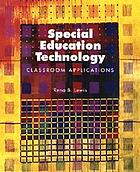Many different types of technology can be used to support and enhance learning. Everything from video content and digital moviemaking to laptop computing and handheld technologies (
Various technologies deliver different kinds of content and serve different purposes in the classroom. For example, word processing and e-mail promote communication skills; database and spreadsheet programs promote organizational skills; and modeling software promotes the understanding of science and math concepts. It is important to consider how these electronic technologies differ and what characteristics make them important as vehicles for education (Becker, 1994).
Technologies available in classrooms today range from simple tool-based applications (such as word processors) to online repositories of scientific data and primary historical documents, to handheld computers, closed-circuit television channels, and two-way distance learning classrooms. Even the cell phones that many students now carry with them can be used to learn (Prensky, 2005).
Each technology is likely to play a different role in students' learning. Rather than trying to describe the impact of all technologies as if they were the same, researchers need to think about what kind of technologies are being used in the classroom and for what purposes. Two general distinctions can be made. Students can learn "from" computers—where technology used essentially as tutors and serves to increase students basic skills and knowledge; and can learn "with" computers—where technology is used a tool that can be applied to a variety of goals in the learning process and can serve as a resource to help develop higher order thinking, creativity and research skills (Reeves, 1998; Ringstaff & Kelley, 2002).
The primary form of student learning "from" computers is what Murphy, Penuel, Means, Korbak and Whaley (2001) describe as discrete educational software (DES) programs, such as integrated learning systems (ILS), computer-assisted instruction (CAI), and computer-based instruction (CBI). These software applications are also among the most widely available applications of educational technology in schools today, along with word-processing software, and have existed in classrooms for more than 20 years (Becker, Ravitz, & Wong, 1999).
According to Murphy et al, teachers use DES not only to supplement instruction, as in the past, but also to introduce topics, provide means for self-study, and offer opportunities to learn concepts otherwise inaccessible to students. The software also manifests two key assumptions about how computers can assist learning. First, the user's ability to interact with the software is narrowly defined in ways designed specifically to promote learning with the tools. Second, computers are viewed as a medium for learning, rather than as tools that could support further learning (Murphy et al, 2001).
While DES remains the most commonly used approach to computer use in student learning, in more recent years, use of computers in schools has grown more diversified as educators recognize the potential of learning "with" technology as a means for enhancing students' reasoning and problem-solving abilities. In part, this shift has been driven by the plethora of new information and communication devices now increasingly available to students in school and at home, each of which offers new affordances to teachers and students alike for improving student achievement and for meeting the demand for 21st century skills describe earlier. No longer limited to school labs, school hours and specific devices, technology access is increasingly centered on the learner experience.
Bruce and Levin (1997), for example, look at ways in which the tools, techniques, and applications of technology can support integrated, inquiry-based learning to "engage children in exploring, thinking, reading, writing, researching, inventing, problem-solving, and experiencing the world." They developed the idea of technology as media with four different focuses: media for inquiry (such as data modeling, spreadsheets, access to online databases, access to online observatories and microscopes, and hypertext), media for communication (such as word processing, e-mail, synchronous conferencing, graphics software, simulations, and tutorials), media for construction (such as robotics, computer-aided design, and control systems), and media for expression (such as interactive video, animation software, and music composition).
In a review of existing evidence of technology's impact on learning, Marshall (2002) found strong evidence that educational technology "complements what a great teacher does naturally," extending their reach and broadening their students' experience beyond the classroom. "With ever-expanding content and technology choices, from video to multimedia to the Internet," Marshall suggests "there's an unprecedented need to understand the recipe for success, which involves the learner, the teacher, the content, and the environment in which technology is used."



 Revolutionizing Education: What We're Learning from Technology-Transformed Schools
Revolutionizing Education: What We're Learning from Technology-Transformed Schools Guide to InFormative Assessment: New Strategies for Using Information to Improve Student Achievement in the 21st Century
Guide to InFormative Assessment: New Strategies for Using Information to Improve Student Achievement in the 21st Century